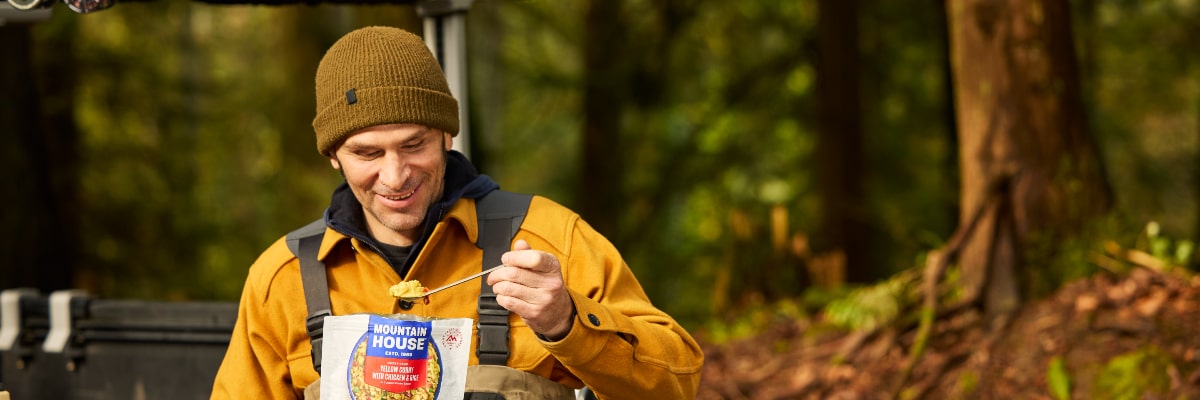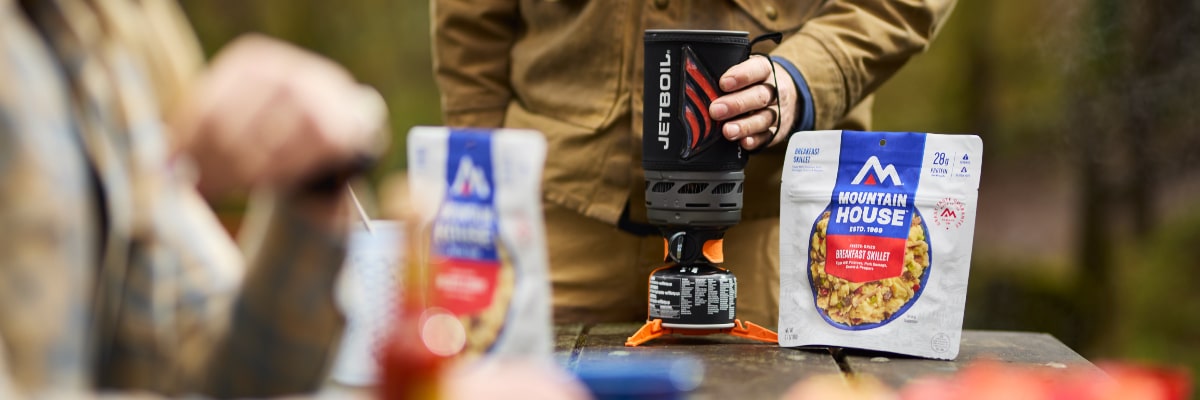Inspired for an Adventure? Check out Beef Stroganoff - Pouch and Beef Stew - Pouch
Free Ground Shipping On All Orders
Over 2,100 Reviews
Add description, images, menus and links to your mega menu
A column with no settings can be used as a spacer
Link to your collections, sales and even external links
Add up to five columns
Add description, images, menus and links to your mega menu
A column with no settings can be used as a spacer
Link to your collections, sales and even external links
Add up to five columns


Mountain House freeze-dried meals have been keeping climbers, soldiers, explorers, hunters, anglers, hikers, backpackers, preppers, and all sorts of other people happily nourished for decades. If you’re reading this, there’s a good chance you’ve already had the pleasure of tucking into one of our dishes—out in some alpine or canyonland campsite, say, or hunkered down in candlelight during a stormy power outage.
But what exactly is freeze-dried food, and how do you go about rehydrating it for consumption? When it comes to how to prepare freeze dried food—well, it really couldn’t be easier. Here we’ll serve up (if you will) steps on how to prepare our ridiculously convenient just-add-hot-water meals, tips on rehydrating other freeze dried foods, and give a short summary of the freeze-drying process for some background.
Mountain House Directions: How to Reconstite Our Freeze-Dried Meals

When preparing freeze-dried food, you're not actually cooking it in the traditional sense, as the food is already cooked. Instead, you're reconstituting it by simply adding water directly to the pouch. This allows the food to regain its original texture, nutrients, and flavor. Once rehydrated, however, you can cook with it by adding new ingredients to your meals, such as fresh garlic to Pasta Primavera or sliced bell peppers to our Breakfast Skillet.
Rehydrating freeze-dried food is as straightforward as it comes with Mountain House packages. We’re not oversimplifying things when we call them “just-add-hot-water meals.” Really—that’s all it takes! To whip up a gourmet Mountain House meal, all you need to do is heat up water (boiling water is preferred) and add it directly to the convenient bowl-like pouch. Before you pour in the water, remember to remove the oxygen absorber packet inside the pouch. (And don’t worry: If you forget to do so before adding water, your food’s still fine—just pluck the packet out of there before you chow down.)
For Mountain House #10 Cans, you can measure out the amount of food you'd like to prepare and cook based on the instructions provided, or prepare the entire can at once by adding the recommended amount of water.
How Much Water Do Mountain House Meals Require?
How much water you need depends on the particular meal: Typical amounts are one, 1 ½, 1 ¾, or two cups.
Example. Our Beef Lasagna meal takes 1 ½ cups of water to complete the rehydration process, while our Scrambled Eggs with Bacon meal only takes 1 cup of water. Just check the directions on the back of the package for the specific water amount.
How Long Do Mountain House Meals Take to Make?
The pouch directions will give you the short-and-sweet timetable for how to make your specific freeze-dried meal. Typically, you’ll add the boiling water, stir the mixture, and seal the pouch to let it sit for eight or nine minutes, stirring midway through if you wish.
Some meals, like our new Korean Inspired Beef, take a bit longer, about 15 minutes, to fully rehydrate.
Can You Rehydrate With Cold Water?
If you can't heat water, cold water will also work to rehydrate your Mountain House meal. Rehydration will take about twice as long, and we think our meals taste better hot, but in an emergency, simply adding cold water will do the trick, too!
How to Rehydrate Other Freeze-Dried Foods
In addition to Mountain House meals, there are other types of freeze-dried foods which can respond differently to rehydration. Fruits and vegetables typically rehydrate quickly with a short soak in cold or warm water, making them ideal for snacks or adding to oatmeal and soups. Meats and dense proteins usually require a longer soak or hotter water to fully return to their original texture.
When rehydrating full meals, it’s best to follow the specific instructions provided. Just be careful not to overdo it; too much water can leave food mushy. Additionally, some freeze-dried foods, like fruits and certain veggies, can also be enjoyed straight from the package as tasty, crunchy snacks without any rehydration.
The Nuts & Bolts of Mountain House's Freeze-Drying Process
The fundamental process of freeze-drying, also known as lyophilization, is actually pretty simple—though it takes some high-tech equipment to pull off at scale like we do here at Mountain House. Here’s how it works, in a nutshell:
-
First, we cook our meals—all of them delectable recipes, from Biscuits & Gravy to our Cheesy Pepperoni Pizza Bowl. (This part of the process smells really good.)
-
Then we transfer the contents of our big cookpots to specially made trays. These go into our massive freezer in order to (you guessed it) freeze the food solid.
-
When the food is nice and frozen, we load up a cart with the trays and wheel it inside a vacuum chamber. To actually make the vacuum within the vessel, we reduce its air pressure to approximately what you’d experience if you were 46 miles above Earth’s surface.
-
Next, we add a small amount of heat beneath the food trays. The one-two punch of the heat and the vacuum turns the ice directly into water vapor, without any liquid phase (aka melted water) in between. In other words, the ice sublimates. We capture the water vapor produced by the sublimation so that it doesn’t re-enter the food. This step typically takes between 12 and 24 hours, depending on what sort of food we’re freeze-drying.
-
The last step is the packaging: a proprietary technique that results in freeze-dried meals and ingredients with the longest shelf life in the industry—and our unbeatable 30-Year Taste Guarantee!
The Advantages of Freeze-Drying
The primary benefit of our freeze-drying method is that it preserves the nutrition, flavor, and texture of our foods. The sublimation of ice into vapor without an intervening liquid state preserves the food's natural pore structure. Therefore, with our just-add-hot-water meals, moisture effectively fills the pores to rehydrate the dish to its pre-frozen form, preserving all of the inherent vitamins, minerals, enzymes, original mouthfeel, and taste.
Rehydrating food, in other words, you get all its innate goodness. And meanwhile, you’ve got lightweight, highly storable, and packable food packages ideal for eating on camping and backpacking adventures as well as storing away in disaster kits, bug-out bags, and other emergency stockpiles.
Prepare Our Just-Add-Water Meals in Any Situation
It’s no secret why military personnel and outdoor recreationists of all stripes have turned to Mountain House just-add-water meals for so many years. Besides all the good stuff we mentioned above—the preserved flavor, texture, and nutritional value of freeze-dried food; the easy-to-pack, easy-to-tote nature of our packages; the exceptionally long shelf life—Mountain House meals are ideal for the backcountry because of their speedy, minimalist preparation.
Rehydrating freeze-dried food requires nothing more than a small amount of water, and while fuel to boil it is optional, it’s highly recommended for the best results. From sparking the stove to your first (mouthwatering) bite, we’re talking about a “cooking” process that takes mere minutes. In our kitchen, freezer, and vacuum chamber, we’ve done basically all of the work for you.
Our easy-to-prepare meals leave you more time for setting up the tent, drying off gear, scouring the map for the next day’s itinerary, soaking up the wilderness sunset, or sneaking in a quick scramble up that alluring-looking summit above camp. In the end, it’s about soaking up the moment, the setting, the experience, and the company (even if it’s just the jays and squirrels). And that's another very important part of the magic of Mountain House.

MRE vs Freeze-Dried Food

What Ingredients Are in Mountain House Freeze-Dried Meals?


Stay Hungry for Adventure
Sign Up for Delicious Outdoor Meals & Exclusive Offers!
By clicking ‘Join Now’, I agree to the Terms of Service and Privacy Policy.


Join the adventure
©2025 Mountain House — All Rights Reserved.
Your Cart is Empty
Continue ShoppingYour Cart
Subtotal
$0.00
EXPRESS PAYMENT METHODS AVAILABLE IN CHECKOUT
Taxes and Shipping Calculated at Checkout
Your ExpertVoice deal.
$[Deal Price]
$[Original Price]
Discount applied at checkout.
On sale now — lower than your ExpertVoice discount.
Not eligible for ExpertVoice discount.














